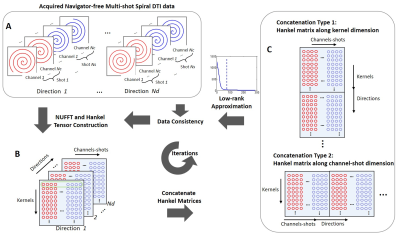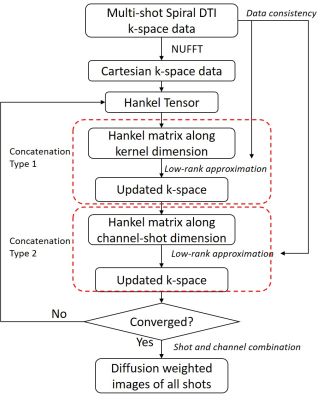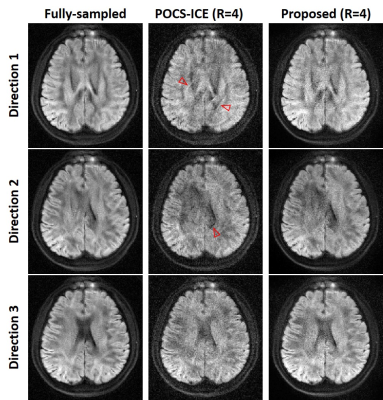4356
Accelerating Navigator-free Multi-shot Spiral DTI via Joint Calibrationless Reconstruction with Low-Rank Tensor Completion1Laboratory of Biomedical Imaging and Signal Processing, The University of Hong Kong, Hong Kong, China, 2Electrical and Electronic Engineering, The University of Hong Kong, Hong Kong, China, 3Electrical and Electronic Engineering, Southern University of Science and Technology, Shenzhen, China, 4Center for Biomedical Imaging Research, Department of Biomedical Engineering, School of Medicine, Tsinghua University, Beijing, China
Synopsis
We propose a novel joint calibrationless reconstruction for accelerating multi-shot navigator-free DTI, using a low-rank completion approach. The redundant information across different directions is utilized to facilitate the reconstruction, including sharable coil sensitivities and anatomical structures. A 3D Hankel tensor was constructed and its concatenated Hankel matrices were used for low-rank approximation. In vivo human brain DTI experiment shows that the proposed joint reconstruction can reduce artifacts in diffusion-weighted images, and yield more accurate DTI metrics, when compared with separate reconstruction for different directions. This method also presents a new potential reconstruction strategy for fast high-resolution DTI.
Introduction
Multi-shot acquisition is a widely used approach for high-resolution diffusion imaging, with shot-to-shot phase variations corrected. The phase variations can either be estimated from extra navigator data, or be calculated from undersampled data of each shot without navigator. Compared with navigator-based acquisition methods, navigator-free methods offer higher acquisition efficiency [1,2]. On the other hand, since navigator-free methods have no calibration data, it is more difficult to be accelerated. In practical applications, acceleration is preferred since multi-shot imaging usually takes long scan time, especially for diffusion tensor imaging (DTI) with multiple diffusion directions. Here we propose a novel joint calibrationless reconstruction for accelerating multi-shot navigator-free DTI, using a low-rank completion approach. In the proposed method, the redundant information across different diffusion directions is utilized to facilitate the reconstruction, including sharable coil sensitivities and anatomical structures.Method
Reconstruction frameworkThe framework of proposed joint calibrationless reconstruction is shown in Figure 1. Firstly, the navigator-free multi-shot and multi-channel DTI data (Figure 1A) were transferred into Cartesian k-space shot-by-shot using NUFFT [3], and constructed into a 3D Hankel tensor (Figure 1B). Based on previous studies [4-6], the low-rank feature of Hankel tensor can be represented by that of the concatenated Hankel matrices. In this study, the Hankel matrices concatenated along the kernel direction and shot-channel direction are used, defined as concatenation Type 1 and Type 2 respectively. The concatenated matrices are processed by low-rank approximation with singular value thresholding, and resorted into the k-space, which will then be updated using data consistency with the acquired k-space data. Those procedures will be iterated until convergency.
The flow-chart of the reconstruction is demonstrated in Figure 2. During each iteration, the two types of concatenation matrices are processed in an alternation way. After the iteration stops, for each channel, data of different shots are averaged after removing their low-resolution phase, and then data of different channels are combined using sum of squares (SOS).
Data acquisition and image reconstruction
Navigator-free multi-shot brain DTI data were acquired using a constant density spiral trajectory on a 3T Achieva MRI scanner (Philips, Best, The Netherlands) with an eight-channel head coil. The imaging parameters were TE/TR = 54/2000 ms, FOV = 220x220 mm2, acquisition matrix = 220x220, number of shots = 8, b-value = 800 s/mm2, and number of diffusion directions = 15 (b = 0 excluded).
The acquired multi-shot DTI data were retrospectively undersampled by a reduction factor (R) of 4, which were complementary among different directions. Using undersampled data, the diffusion-weighted images of different directions were reconstructed separately with POCS-enhanced Inherent Correction of Phase Errors (POCS-ICE) [2], and reconstructed simultaneously with the proposed joint reconstruction method. The fully-sampled data were reconstructed using POCS-ICE as the reference. Note that the b=0 data were fully-sampled and reconstructed separately using NUFFT.
Using reconstructed diffusion-weighted images, DTI metrics were calculated with DtiStudio [7], including mean ADC, Fractional Anisotropy (FA) and color-coded FA maps.
Results
Figure 3 shows the diffusion-weighted images reconstructed from the fully-sampled data, the highly undersampled data of R=4 using POCS-ICE reconstruction and our proposed joint reconstruction framework. Three representative directions were shown. Compared with POCS-ICE, the reconstructed images by the proposed joint reconstruction yield the reduced aliasing artifacts (marked with red arrowheads) and a lower noise level. As shown in Figure 4, the FA and color-coded FA maps from proposed reconstruction are closer to those from fully-sampled reference than POCS-ICE. The mean ADC map from the proposed reconstruction also shows the substantially reduced aliasing artifacts (yellow arrowheads).Discussion and Conclusions
The joint reconstruction proposed in this study improves the quality of image reconstruction from significantly undersampled multi-shot DTI data by exploiting the sharable coil sensitivities and image contents/structures across multiple diffusion directions with a low-rank completion approach. It is noteworthy that data of different shots are treated as different channels, and no additional phase correction is needed during the iteration. Therefore, no calibration data are required and navigator-free acquisition can be used, which can improve the acquisition efficiency.In this study, 15 diffusion directions were acquired in the experiment. If more directions are acquired, the low-rank property of Hankel tensor can be enhanced, so the image quality can be further improved. Although multi-shot spiral was used here for demonstration, the proposed reconstruction can easily be extended to other multi-shot DTI methods, such as multi-shot EPI DTI.
In conclusion, we have developed a novel joint calibrationless reconstruction for highly accelerated multi-shot DTI. This approach can also potentially be used for fast high-resolution DTI in both basic neuroscience and clinical applications.
Acknowledgements
This study is supported in part by Hong Kong Research Grant Council (C7048-16G and HKU17115116 to E.X.W. and HKU17103819 to A.T.L.), Guangdong Key Technologies for Treatment of Brain Disorders (2018B030332001) and Guangdong Key Technologies for Alzheimer's Disease Diagnosis and Treatment (2018B030336001) to E.X.W.References
[1] Chen, N.K., Guidon, A., Chang, H.C., Song, A.W., 2013. A robust multi-shot scan strategy for high-resolution diffusion weighted MRI enabled by multiplexed sensitivity-encoding (MUSE). NeuroImage 72, 41-47
[2] Guo, H., Ma, X., Zhang, Z., Zhang, B., Yuan, C., Huang, F., 2016. POCS-enhanced inherent correction of motion-induced phase errors (POCS-ICE) for high-resolution multishot diffusion MRI. Magn. Reson. Med. 75, 169-180
[3] Fessler JA, Sutton BP. Nonuniform fast Fourier transforms using min- max interpolation. IEEE Trans Signal Process 2003;51:560-574
[4] P. J. Shin, P. E. Larson, M. A. Ohliger, M. Elad, J. M. Pauly, D. B. Vigneron, et al., "Calibrationless parallel imaging reconstruction based on structured low-rank matrix completion," Magn Reson Med, vol. 72, pp. 959-70, Oct 2014
[5] Yilong Liu, Jun Cao, Mengye Lyu, and Ed X. Wu, Calibrationless Parallel Imaging Reconstruction Using Hankel Tensor Completion (HTC), ISMRM 2017, #0445
[6] Zheyuan Yi, Yilong Liu, Yujiao Zhao, Fei Chen, and Ed X. Wu, Joint Calibrationless Reconstruction of Highly Undersampled Multi-Contrast MR Datasets Using A Novel Low-Rank Completion Approach, ISMRM 2019, #4746
[7] Jiang, H., van Zijl, P.C., Kim, J., Pearlson, G.D., Mori, S., 2006. DtiStudio: resource program for diffusion tensor computation and fiber bundle tracking. Comput. Methods Prog. Biomed. 81, 106-116
Figures



